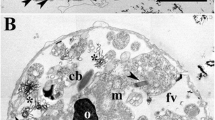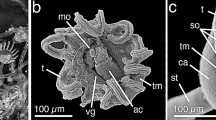Summary
Tentacle structure, movement and feeding of the commensal suctorian Choanophrya infundibulifera have been examined by light, scanning and transmission electron microscopy. The tentacles possess a flattened tip and rounded shaft externally, with a neck and root region internally. There is a microtubule canal consisting of 150 ring microtubules within which are 20–35 curved lamellae each containing about 20 microtubules. Novel structural features include pairs of short oblique arranged microtubules at the tip, and a collar of epiplasm in the neck region. No haptocysts are found in Choanophrya but the tentacle cytoplasm contains two types of inclusions named solenocysts and spherical vesicles. These features are discussed in relation to the processes of tentacle movement and feeding. The rapid longitudinal movements of the tentacles are described and compared to those of other suctorians and possible mechanisms are suggested. Ingestion in Choanophrya is described and several theories involving tentacle microtubules in the feeding process are examined.
Similar content being viewed by others
References
Allen, T.D.: Cytological studies of Dendrocometes paradoxus Stein. Ph. D. Thesis, University of Manchester (1970)
André, J., Fauré-Fremiet, E.: Lésions cytoplasmiques provoquées chez un Cilié par un Tentaculifère parasite. Protistologica 3, 121–126 (1967)
Bannister, L.H., Tatchell, E.C.: Contractility and the fibre systems of Stentor coeruleus. J. Cell Sci. 3, 295–308 (1968)
Bardele, C.F.: Acineta tuberosa. I. Der Feinbau des adulten Suktors. Arch. Protistenk. 110, 403–421 (1968)
Bardele, C.F.: Budding and metamorphosis in Acineta tuberosa. An electron microscopic study on morphogenesis in Suctoria. J. Protozool. 17, 51–70 (1970)
Bardele, C.F.: Microtubule model systems: cytoplasmic transport in the suctorian tentacle and the centrohelidian axopod. 29th Ann. Proc. Electron Microscopy Soc. Amer. (1971)
Bardele, C.F.: A microtubule model for ingestion and transport in the suctorian tentacle. Z. Zellforsch. 126, 116–134 (1972)
Bardele, C.F., Grell, K.G.: Elektronenmikroskopische Beobachtungen zur Nahrungsaufnahme bei dem Suktor Acineta tuberosa Ehrenberg. Z. Zellforsch. 80, 108–123 (1967)
Batisse, A.: Les appendices préhenseurs d'Ephelota gemmipara, Hertwig C. R. Acad. Sci. (Paris) 261, 5620–5632 (1965)
Batisse, A.: L'ultrastructure des tentacles suceurs d'Ephelota gemmipara Hertwig. C. R. Acad. Sci. (Paris) 262, 771–744 (1966)
Batisse, A.: Le développement des phialocystes chez les acinétiens C. R. Acad. Sci. (Paris) 265, 972–974 (1967a)
Batisse, A.: Données nouvelles sur la structure et le fonctionnement des ventouses tentaculaires des Acinetiens. C. R. Acad. Sci. (Paris) 265, 1056–1058 (1967b)
Batisse, A.: Quelques aspects de l'ultrastructure de Pseudogemma pachystyla Collin. Protistologica 4, 271–282 (1968)
Batisse, A.: Les structures pedonculaires dans les genres Tokophrya Butschli et Choanophrya Hartog. (Ciliata, Suctorida) Protistologica 5, 387–412 (1969)
Bennett, H.S.: The cell surface. In: Handbook of molecular cytology (Lima-de-Faria, ed.). p. 1261–1319. Amsterdam: North Holland Publ. Co. 1969
Bluemink, J.G.: Cortical wound healing in the amphibian egg: An electron microscopical study. J. Ultrastruct. Res. 41, 95–114 (1972)
Bütschli, O.: Protozoa. Bronn's „Klassen und Ordnungen des Thierreichs“. Bd. I. 3, (1887–1889)
Canella, M.F.: Studi e ricerche sui Tentaculiferi nel quadro della biologia generale. Ann. Univ. Ferrara Sez. III 1, 1–716 (1957)
Collin, B.: Etude monographique sur les Acinétiens. II. Morphologie, physiologie systematique. Arch. Zool. exp. gen. 51, 1–457 (1912)
Eismond, J.: Zur Frage über den Saugmechanismus bei Suctorien. Zool. Anz. 13, 721–723 (1890)
Farkas, B.: Beiträge zur Kenntnis der Suctorien. Arch. Protistenk. 48, 125–135 (1924)
Fauré-Fremiet, E.: Pouvoir lytique et phosphatase acide chez les ciliés. C. R. Acad. Sci. (Paris) 254, 2691–2693 (1962)
Fauré-Fremiet, E., André, J.: L'organisation corticale des Ciliata. C. R. Acad. Sci. (Paris) 266, D 487–490 (1968)
Forer, A., Behnke, O.: An actin-like component in sperm tails of a crane fly (Nephrotoma suturalis Loew). J. Cell Sci. 11, 491–519 (1972)
Fryer, G.: The food of some freshwater cyclopoid copepods and its ecological significance. J. Anim. Ecol. 26, 263–286 (1957)
Grell, K.G.: Ephelota gemmipara (Suctoria). Nahrungsaufnahme und Fortpflanzung. Film E 1017 der Enc. Cin., Göttingen 1965
Harding, J.P., Smith, W.A.: A key to the British freshwater cyclopid and calanoid copepods. F. W. Biol. Ass. Sci. Publ. 18 (1960)
Hartog, M.M.: Notes on Suctoria. Arch. Protistenk. 1, 372–374 (1901)
Hartog, M.M.: Protozoa. “The Cambridge Natural History” (Harmer, S.F. and Shipley, A.E.) vol. I, p. 3–162. London: Macmillan 1906
Hauser, M.: Elektronenmikroskopische Untersuchung an dem Suktor Paracineta limbata Maupas. Z. Zellforsch. 106, 594–614 (1970)
Heckmann, K.: Tokophrya lemnarum (Suctoria) Nahrungsaufnahme und Schwärmerbildung. Film E 913 der Enc. Cin., Göttingen 1964/65
Hertwig, R.: Über Podophrya gemmipara nebst Bemerkungen zum Bau und zur systematischen Stellung der Acineat. Morph. Jb. 1, 20–82 (1876)
Hitchen, E.T.: A cytological study of Choanophrya infundibulifera Hartog and Rhyncheta cyclopum Zenker. Ph. D. Thesis, University of Manchester (1972)
Hitchen, E.T., Butler, R.D.: A redescription of Rhyncheta cyclopum Zenker; (Ciliata, Suctorida). J. Protozool. 19, 597–601 (1972)
Huang, B.: Microtubule sliding generated by inter-tubule bridges. J. Cell Biol. Abstr. 55, No. 238, 119 (1972)
Hull, R.W.: Studies on suctorian protozoa: The mechanism of ingestion of prey cytoplasm. J. Protozool. 8, 351–359 (1961)
Jurand, A., Bomford, R.: The fine structure of the parasitic suctorian Podophrya parameciorum. J. Microscopie 4, 509–522 (1965)
Kahl, A.: Über die verwandschaftlichen Beziehungen der Suctorien zu den prostomen Infusorien. Arch. Protistenk. 73, 432–481 (1931)
Kitching, J.A.: On suction in suctoria. Colston Papers Proc. 7th Symp. Colston Res. Soc. 7, 197–203 (1954)
Kormos, J.: Bau und Funktion der Saugröhrchen der Suctorien. Allatani Kozlemenyek 35, 130–153 (1938)
McIntosh, J.R.: The axostyle of Saccinobaculus. II. Motion of the microtubule bundle and a structural comparison of straight and bent axostyles. J. Cell Biol. 56, 324–339 (1973)
Mollenhauer, H.M.: Plastic embedding mixtures for use in electron microscopy. Stain Technol. 39, 111–114 (1964)
Olson, L.W., Heath, I.B.: Observations on the ultrastructure of microtubules. Z. Zellforsch. 115, 388–395 (1971)
Pestel, B.: Beiträge zur Morphologie und Biologie des Dendrocometes paradoxus. Stein. Arch. Protistenk. 75, 403–471 (1931)
Pollard, T.D., Korn, E.D.: Filaments of Amoeba proteus. II. Binding of heavy meromyosin by thin filaments in motile cytoplasmic extracts. J. Cell Biol. 48, 216–219 (1971)
Pollard, T.D., Shelton, E., Weihing, R.R., Korn, E.D.: Ultrastructural characterization of F-actin isolated from Acanthamoeba castellanii and identification of cytoplasmic filaments as F-actin by reaction with rabbit heavy meromyosin. J. molec. Biol. 50, 91–97 (1965)
Root, F.M.: Reproduction and reaction to food in the suctorian, Podophrya collini n. sp. Arch. Protistenk. 35, 64–196 (1914)
Roth, L.E., Pihlaja, D.J., Shigenaka, Y.: Microtubules in the Helizoan axopodium. I. The gradion hypothesis of allosterism in structural proteins. J. Ultrastruct. Res. 30, 7–37 (1970)
Rudzinska, M.A.: The fine structure and function of the tentacle in Tokophrya infusionum. J. Cell Biol. 25, 459–477 (1965)
Rudzinska, M.A.: Ultrastructures involved in the feeding mechanism of Suctoria. Trans. N.Y. Acad. Sci. 29, 512–525 (1967)
Rudzinska, M.A.: The mechnism of food intake in Tokophrya infusionum and ultrastructural changes in food vacuoles during digestion. J. Protozool. 17, 626–641 (1970)
Rudzinska, M.A.: Ultrastructural localization of acid phosphatase in feeding Tokophrya infusionum. J. Protozool. 19, 618–629 (1972)
Satir, P.: Studies on Cilia III. Further studies on the cilium tip and a “sliding filament” model of ciliary motility. J. Cell Biol. 29, 77–94 (1968)
Sleigh, M.A.: The physiology and biochemistry of cilia and flagella. In: Handbook of molecular cytology (ed. Lima-de-Faria) 1243–1260. Amsterdam: North Holland Publ. Co. 1969
Small, E.B., Marszalek, D.S.: Scanning electron microscopy of fixed, frozen and dried Protozoa. Science 163, 1064–1065 (1969)
Smith, D.S.: On the significance of cross-bridges between microtubules and synaptic vesicles. Phil. Trans. B 261, 395–405 (1971)
Spurr, A.R.: A low-viscosity epoxy resin embedding medium for electron microscopy. J. Ultrastruct. Res. 26, 31–43 (1969)
Squier, C.A., Waterhouse, J.P., Linder, J.E.: A comparison between osmiophilic reagents and the Gomori lead method for the electron cytochemical demonstration of two lysosomal enzymes in oral epithelium. Histochem. J. 2, 91–107 (1970)
Szubinska, B.: “New membrane” formation in Amoeba proteus upon injury of individual cells. Electron microscope observations. J. Cell Biol. 49, 747–772 (1971)
Tucker, J.B.: Fine structure and function of the cytopharyngeal basket in the ciliate Nassula. J. Cell Sci. 3, 493–514 (1968)
Tucker, J.B.: Microtubule-arms and propulsion of food particles inside a large feeding organelle in the ciliate Phascolodon vorticella J. Cell Sci. 10, 883–903 (1972)
Venable, J.H., Coggeshall, R.: A simplified lead citrate stain for use in electron microscopy. J. Cell Biol. 25, 407–408 (1965)
Vickerman, K.: On the surface coat and flagellar adhesion in trypanosomes. J. Cell Sci. 5, 163–194 (1969)
Zachariah, Z., Pasternak, J.: Processing soft tissues for scanning electron microscopy. Simplification of the freeze-drying procedures. Stain Technol. 45, 43–45 (1970)
Zenker, W.: Beiträge zur Naturgeschichte der Infusorien. Arch. Mikr. Anat. 2, 332–348 (1866)
Author information
Authors and Affiliations
Additional information
This investigation was supported by the J.S. Dunkerley Fellowship in Protozoology, awarded by the University of Manchester.
Rights and permissions
About this article
Cite this article
Hitchen, E.T., Butler, R.D. Ultrastructural studies of the commensal suctorian, Choanophyra infundibulifera hartog. Z.Zellforsch 144, 37–57 (1973). https://doi.org/10.1007/BF00306685
Received:
Issue Date:
DOI: https://doi.org/10.1007/BF00306685




